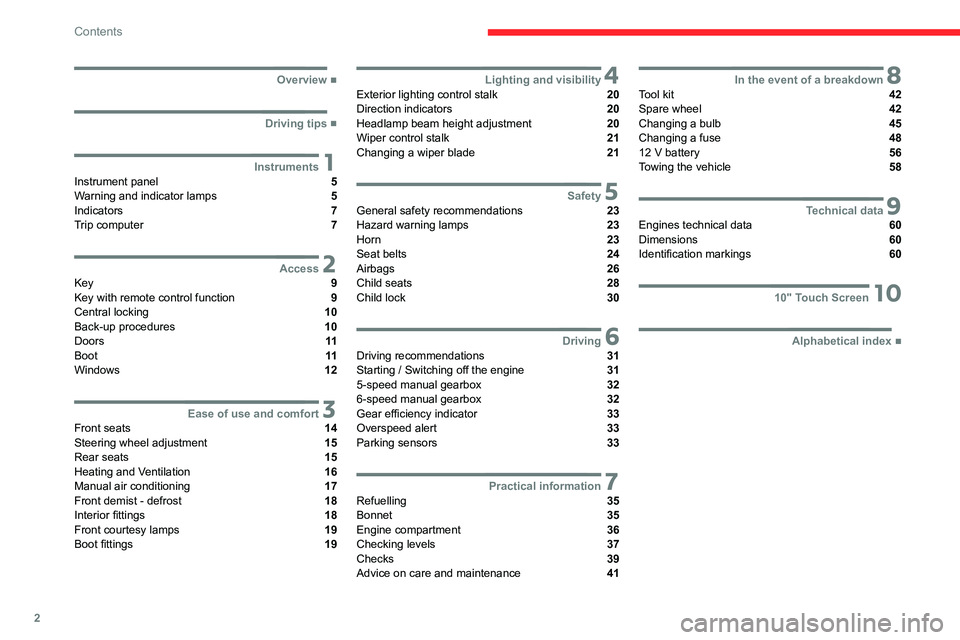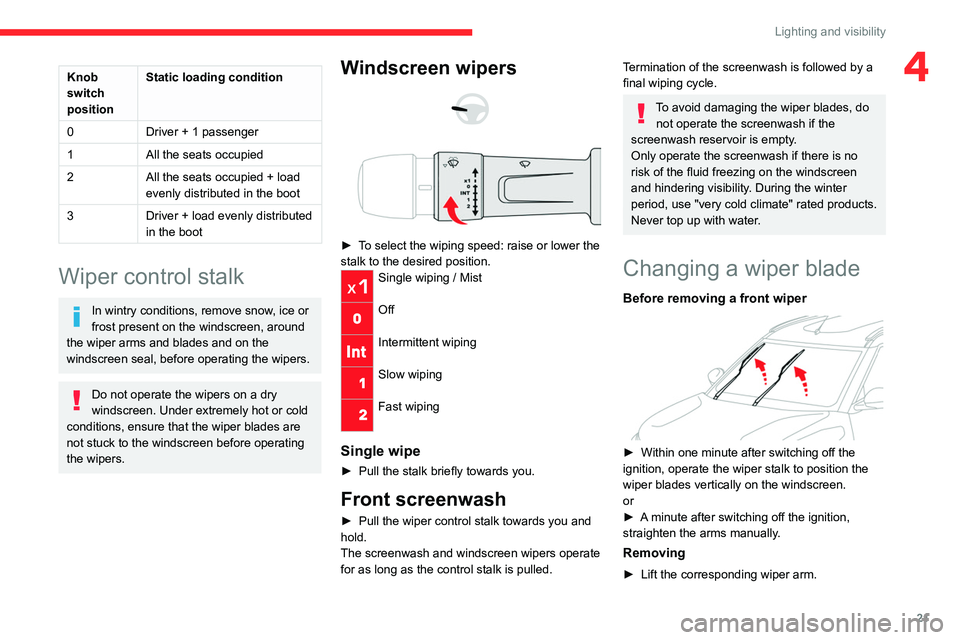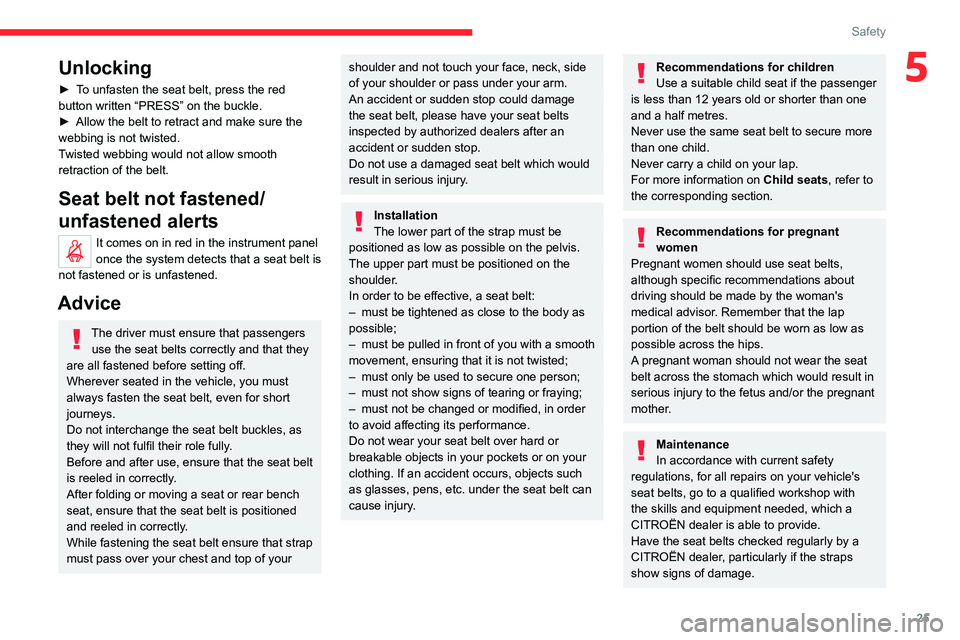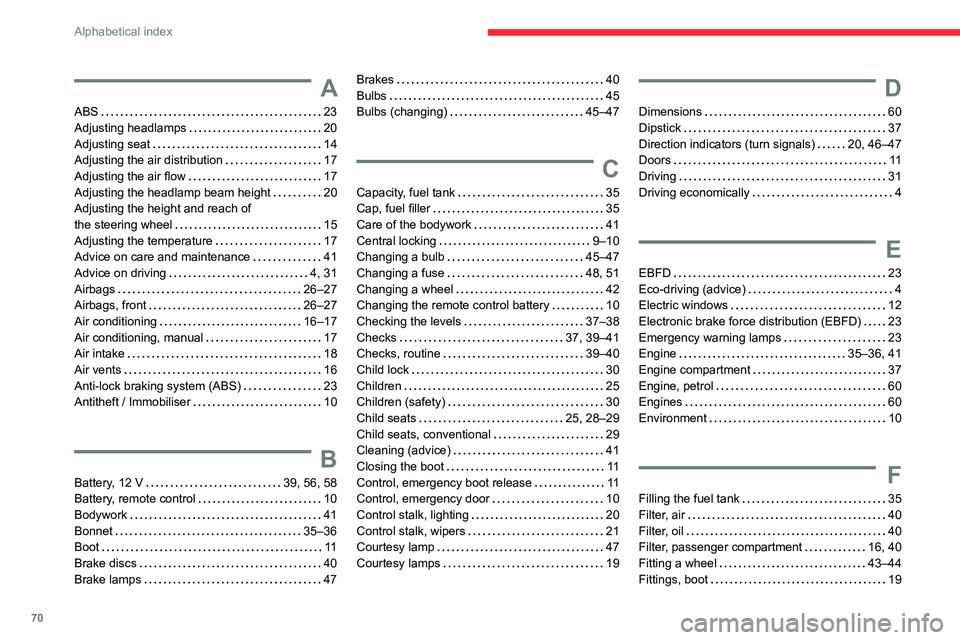seats CITROEN C3 2023 Owners Manual
[x] Cancel search | Manufacturer: CITROEN, Model Year: 2023, Model line: C3, Model: CITROEN C3 2023Pages: 104, PDF Size: 2.38 MB
Page 4 of 104

2
Contents
■
Overview
■
Driving tips
1InstrumentsInstrument panel 5
Warning and indicator lamps 5
Indicators 7
Trip computer 7
2AccessKey 9
Key with remote control function 9
Central locking 10
Back-up procedures 10
Doors 11
Boot 11
Windows 12
3Ease of use and comfortFront seats 14
Steering wheel adjustment 15
Rear seats 15
Heating and Ventilation 16
Manual air conditioning 17
Front demist - defrost 18
Interior fittings 18
Front courtesy lamps 19
Boot fittings 19
4Lighting and visibilityExterior lighting control stalk 20
Direction indicators 20
Headlamp beam height adjustment 20
Wiper control stalk 21
Changing a wiper blade 21
5SafetyGeneral safety recommendations 23
Hazard warning lamps 23
Horn 23
Seat belts 24
Airbags 26
Child seats 28
Child lock 30
6DrivingDriving recommendations 31
Starting / Switching off the engine 31
5-speed manual gearbox 32
6-speed manual gearbox 32
Gear efficiency indicator 33
Overspeed alert 33
Parking sensors 33
7Practical informationRefuelling 35
Bonnet 35
Engine compartment 36
Checking levels 37
Checks 39
Advice on care and maintenance 41
8In the event of a breakdownTool kit 42
Spare wheel 42
Changing a bulb 45
Changing a fuse 48
12
V battery 56
Towing the vehicle 58
9Technical dataEngines technical data 60
Dimensions 60
Identification markings 60
1010" Touch Screen
■
Alphabetical index
Page 14 of 104

12
Access
To unlock the boot
► Fold the rear seats to gain access to the lock
from inside the boot.
►
Insert the hand inside the tailgate right cutout
area.
►
Press the lever downwards to release the
lock.
Next option to unlock the boot:
► Fold the rear seats to gain access to the lock
from inside the boot.
►
Press the lever by following the arrow
direction to release the lock.
To re-lock the boot
If the problem persists, the boot will remain
locked after opening and closing.
Windows
Electric windows
Control switch at driver door
1. Left-hand front
2. Right-hand front
Control switch at console (depending on
version)
3.Left-hand rear
4. Right-hand rear
Operation
Opening
► Press the switch; the window stops as soon
as the switch is released.
►
One touch-down: press the switch past its
resistance point; the window opens completely
when the switch is released.
Closing
► Pull the switch; the window stops as soon as
the switch is released.
Page 16 of 104

14
Ease of use and comfort
Correct driving position
For safety reasons, adjustments must
only be made when the vehicle is
stationary.
Before taking to the road and to make the most
of the ergonomic layout of the instruments and
controls, carry out these adjustments in the
following order:
–
seat backrest angle.
–
seat cushion height.
–
longitudinal seat position.
–
steering wheel height.
–
rear view mirror and door mirrors.
–
seat belt fastened.
Once these adjustments have been
made, check that the instrument panel
can be viewed correctly from your driving
position.
Front seats
Before moving the seat backwards,
ensure that there is nothing that might
prevent the full travel of the seat.
There is a risk of trapping or pinching
passengers if present in the rear seats or
jamming the seat if large objects are placed
on the floor behind the seat.
Longitudinal adjustment
► Raise the control bar and slide the seat
forwards or backwards.
►
Release the bar to lock the seat in position on
one of the runners.
Backrest angle adjustment
► Raise the control lever to the maximum
height in order to avoid noise and mechanism
failure.
Height adjustment
(Driver only, depending on version)
► Raise or lower the control as many times as
needed.
Avoid stepping on these plastic parts - Risk of injury or damaging the
components!
Page 17 of 104

15
Ease of use and comfort
3Steering wheel
adjustment
► When stationary, hold the steering wheel on
one hand and pull the control lever to release the
steering wheel.
►
Adjust the height to suit your driving position.
►
Push the control lever to lock the steering
wheel.
As a safety measure, these adjustments must only be carried out with the vehicle
stationary.
Door mirrors
Objects viewed in the door mirror on the
passenger side are closer than they
appear. Be careful when moving to the right.
Using only this mirror could cause an
accident. Use the inside mirror or glance over
your shoulder to properly judge distances to
other objects.
Do not adjust the mirrors while driving.
You could lose control of your vehicle
and cause an accident.
Manual adjustment
► Move directly the mirror in any direction to
adjust it.
Manual adjustment with the
control
► Move the lever in any direction to adjust it.
If the mirror unit has come out of its initial
position, with the vehicle stationary
, push it back
into place manually or use the control.
There is no risk of breakage, even in frosty
weather.
Manual folding
The mirrors can be folded manually (parking
obstruction, narrow garage, etc.).
►
T
urn the mirror towards the vehicle.
Rear seats
Folding the backrest
Manoeuvring the seat backrest should
only be done when the vehicle is
stationary.
Page 18 of 104

16
Ease of use and comfort
► If necessary, move the front seats forward.
► Check that no person or object will interfere
with folding down the backrest (clothing,
luggage, etc.).
►
Check that the outer seat belts are lying flat
on the backrest.
► Pull the rope 1 up and fold the backrest 2
inwards to increase boot space.
Repositioning the backrest
First check that the outer seat belts are
lying vertically flat alongside the backrest
latching rings.
►
Put the backrest
2 in the upright position and
push it firmly to latch it home.
►
Ensure that the outer seat belts were not
trapped during the operation.
Please note: an incorrectly latched
backrest compromises the safety of
passengers in the event of sudden braking or
an accident.
The contents of the boot may be thrown
forward - risk of serious injury!
Heating and Ventilation
Air intake
The air circulating in the passenger compartment
is filtered and originates either from the
exterior, via the grille located at the base of the
windshield, or from the inside in air recirculation
mode.
Controls
The controls are grouped together in the control
panel on the centre console.
Air distribution
1. Windshield defroster outlets
2. Side defroster outlets
3. Side outlets
4.Central outlets
5. Floor outlets
Advice
Using the ventilation and air
conditioning system
►
T
o ensure that air is distributed evenly,
keep the external air intake grilles at the base
of the windscreen, the nozzles, the vents, the
air outlets and the air extractor in the boot
free from obstructions.
►
Operate the air conditioning system for at
least 5 to 10 minutes once or twice a month to
keep it in perfect working order
.
►
If the system does not produce cold air
,
switch it off and contact a CITROËN dealer.
Avoid driving for too long with the ventilation off or with prolonged operation
of interior air recirculation. Risk of misting and
deterioration of the air quality!
If the interior temperature is very high
after the vehicle has stood for a long
time in the sunshine, drive with the windows
open for a few moments to air the passenger
compartment.
Put the air flow control at a setting high
enough to quickly change the air in the
passenger compartment.
Page 23 of 104

21
Lighting and visibility
4Knob
switch
positionStatic loading condition
0 Driver + 1 passenger
1 All the seats occupied
2 All the seats occupied + load
evenly distributed in the boot
3 Driver + load evenly distributed
in the boot
Wiper control stalk
In wintry conditions, remove snow, ice or
frost present on the windscreen, around
the wiper arms and blades and on the
windscreen seal, before operating the wipers.
Do not operate the wipers on a dry
windscreen. Under extremely hot or cold
conditions, ensure that the wiper blades are
not stuck to the windscreen before operating
the wipers.
Windscreen wipers
► To select the wiping speed: raise or lower the
stalk to the desired position.
Single wiping / Mist
Off
Intermittent wiping
Slow wiping
Fast wiping
Single wipe
► Pull the stalk briefly towards you.
Front screenwash
► Pull the wiper control stalk towards you and
hold.
The screenwash and windscreen wipers operate
for as long as the control stalk is pulled.
Termination of the screenwash is followed by a
final wiping cycle.
To avoid damaging the wiper blades, do not operate the screenwash if the
screenwash reservoir is empty.
Only operate the screenwash if there is no
risk of the fluid freezing on the windscreen
and hindering visibility. During the winter
period, use "very cold climate" rated products.
Never top up with water.
Changing a wiper blade
Before removing a front wiper
► Within one minute after switching off the
ignition, operate the wiper stalk to position the
wiper blades vertically on the windscreen.
or
►
A
minute after switching off the ignition,
straighten the arms manually.
Removing
► Lift the corresponding wiper arm.
Page 26 of 104

24
Safety
When changing wheels (tyres and rims),
ensure that these are approved by the
manufacturer for your vehicle.
After an impact, have these systems checked by a CITROËN dealer.
Seat belts
Inertia reel
The seat belts are equipped with an inertia reel
which allows the strap length to automatically
adjust to your shape. The seat belt returns to its
storage automatically when it is not used.
The inertia reels are fitted with a device which
automatically locks the strap in the event of a
collision, emergency braking or if the vehicle rolls
over. It can be released by pulling the strap firmly
and then releasing it so that it reels in slightly.
Force limiter
This system reduces the pressure of the seat
belt on the chest of the occupant, thus improving
their protection.
Front seat belts
The front driver seat belt is fitted with inertia reel
and a force limiting system.
The front passenger seat belt is equipped with
inertia reel.
Rear seat belts
The outer seats have a belt with inertia reel.
Before performing any operations on the
rear seats, to avoid damage to the seat
belts, check that:
–
the outer seat belts are correctly in the
storage position, lying vertically along the
pillar
,
–
the central seat belt is stowed.
Fastening
► To fasten the seat belt, pull the webbing and
insert the tongue into the buckle.
►
Check whether the seat belt is fastened
correctly by pulling the webbing.
If the driver or co-driver seat belt is not fastened
while the ignition is ON, the seat belt warning
lamp chimes and illuminates until the seat belt is
fastened.
Page 27 of 104

25
Safety
5Unlocking
► To unfasten the seat belt, press the red
button written “PRESS” on the buckle.
►
Allow the belt to retract and make sure the
webbing is not twisted.
T
wisted webbing would not allow smooth
retraction of the belt.
Seat belt not fastened/
unfastened alerts
It comes on in red in the instrument panel
once the system detects that a seat belt is
not fastened or is unfastened.
Advice
The driver must ensure that passengers use the seat belts correctly and that they
are all fastened before setting off.
Wherever seated in the vehicle, you must
always fasten the seat belt, even for short
journeys.
Do not interchange the seat belt buckles, as
they will not fulfil their role fully.
Before and after use, ensure that the seat belt
is reeled in correctly.
After folding or moving a seat or rear bench
seat, ensure that the seat belt is positioned
and reeled in correctly.
While fastening the seat belt ensure that strap
must pass over your chest and top of your
shoulder and not touch your face, neck, side
of your shoulder or pass under your arm.
An accident or sudden stop could damage
the seat belt, please have your seat belts
inspected by authorized dealers after an
accident or sudden stop.
Do not use a damaged seat belt which would
result in serious injury.
Installation
The lower part of the strap must be
positioned as low as possible on the pelvis.
The upper part must be positioned on the
shoulder.
In order to be effective, a seat belt:
–
must be tightened as close to the body as
possible;
–
must be pulled in front of you with a smooth
movement, ensuring that it is not twisted;
–
must only be used to secure one person;
–
must not show signs of tearing or fraying;
–
must not be changed or modified, in order
to avoid affecting its performance.
Do not wear your seat belt over hard or
breakable objects in your pockets or on your
clothing. If an accident occurs, objects such
as glasses, pens, etc. under the seat belt can
cause injury
.
Recommendations for children
Use a suitable child seat if the passenger
is less than 12 years old or shorter than one
and a half metres.
Never use the same seat belt to secure more
than one child.
Never carry a child on your lap.
For more information on Child seats, refer to
the corresponding section.
Recommendations for pregnant
women
Pregnant women should use seat belts,
although specific recommendations about
driving should be made by the woman's
medical advisor. Remember that the lap
portion of the belt should be worn as low as
possible across the hips.
A pregnant woman should not wear the seat
belt across the stomach which would result in
serious injury to the fetus and/or the pregnant
mother.
Maintenance
In accordance with current safety
regulations, for all repairs on your vehicle's
seat belts, go to a qualified workshop with
the skills and equipment needed, which a
CITROËN dealer is able to provide.
Have the seat belts checked regularly by a
CITROËN dealer, particularly if the straps
show signs of damage.
Page 30 of 104

28
Safety
Child seats
Warning label on the sun visor - Front
passenger airbag
NEVER use a rearward facing child restraint on a seat protected by an ACTIVE AIRBAG
in front of it, SERIOUS INJURY to the CHILD may occur.
Do not install a rear-facing child restraint
on the front passenger’s seat.
A child in a rear-facing child restraint could be seriously harmed if the
passenger's front airbag inflates. The inflated
airbag would be too close to the back of a
rear-facing child restraint.
An incorrectly installed child seat compromises the child's safety in the
event of an accident.
Ensure that there is no seat belt or seat belt
buckle under the child seat, as this could
destabilise it.
Remember to fasten the seat belts or the
harness of child seats, keeping the slack
relative to the child's body to a minimum,
even for short journeys.
When installing a child seat using the seat
belt, ensure that the seat belt is tightened
correctly on the child seat and that it secures
the child seat firmly on the seat of the vehicle.
Ensure that the head restraint is stored or
attached securely to prevent it from being
thrown around the vehicle in the event of
sharp braking. Refit the head restraint once
the child seat has been removed.
Additional protections
To prevent accidental opening of the
doors and rear windows, use the "Child lock".
Take care not to open the rear windows by
more than one third.
To protect young children from the rays of the
sun, fit side blinds on the rear windows.
As a safety precaution, do not leave:
–
a child alone and unattended in a vehicle,
–
a child or an animal in a vehicle which is
exposed to the sun, with the windows closed,
–
the keys within reach of children inside the
vehicle.
Page 72 of 104

70
Alphabetical index
A
ABS 23
Adjusting headlamps
20
Adjusting seat
14
Adjusting the air distribution
17
Adjusting the air flow
17
Adjusting the headlamp beam height
20
Adjusting the height and reach of
the steering wheel
15
Adjusting the temperature
17
Advice on care and maintenance
41
Advice on driving
4, 31
Airbags
26–27
Airbags, front
26–27
Air conditioning
16–17
Air conditioning, manual
17
Air intake
18
Air vents
16
Anti-lock braking system (ABS)
23
Antitheft / Immobiliser
10
B
Battery, 12 V 39, 56, 58
Battery, remote control
10
Bodywork
41
Bonnet
35–36
Boot
11
Brake discs
40
Brake lamps
47
Brakes 40
Bulbs
45
Bulbs (changing)
45–47
C
Capacity, fuel tank 35
Cap, fuel filler
35
Care of the bodywork
41
Central locking
9–10
Changing a bulb
45–47
Changing a fuse
48, 51
Changing a wheel
42
Changing the remote control battery
10
Checking the levels
37–38
Checks
37, 39–41
Checks, routine
39–40
Child lock
30
Children
25
Children (safety)
30
Child seats
25, 28–29
Child seats, conventional
29
Cleaning (advice)
41
Closing the boot
11
Control, emergency boot release
11
Control, emergency door
10
Control stalk, lighting
20
Control stalk, wipers
21
Courtesy lamp
47
Courtesy lamps
19
D
Dimensions 60
Dipstick
37
Direction indicators (turn signals)
20, 46–47
Doors
11
Driving
31
Driving economically
4
E
EBFD 23
Eco-driving (advice)
4
Electric windows
12
Electronic brake force distribution (EBFD)
23
Emergency warning lamps
23
Engine
35–36, 41
Engine compartment
37
Engine, petrol
60
Engines
60
Environment
10
F
Filling the fuel tank 35
Filter, air
40
Filter, oil
40
Filter, passenger compartment
16, 40
Fitting a wheel
43–44
Fittings, boot
19